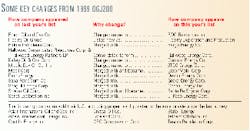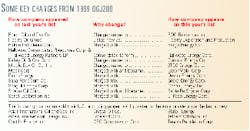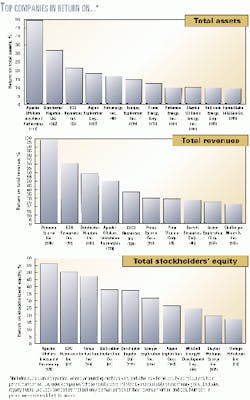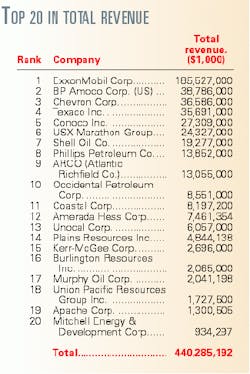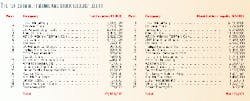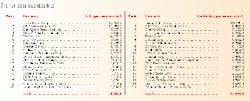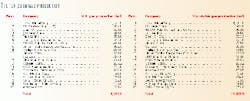Financial and operating results for 1999 of companies on the OGJ200 list of publicly traded oil and gas producing companies in the US mostly reflected improvement over a dismal 1998.
About two-thirds of the 200 companies made a profit in 1999, up from only one third in 1998. Return on stockholder equity was more than 5 times better than 1998's record low.
The list of fastest-growing companies sprang back to life in 1999 after almost drying up the previous year.
With crude oil demand surging and production unable to keep pace, many companies rode the wave of higher prices. Combined net income for the 200 companies of $22.3 billion was six times that of 1998. It was also only two thirds that of the 1996 record.
More companies showed growth last year by increasing net income and stockholder equities.
After explaining to stockholders why the bottom line was so grim for 1998, oil company officials found themselves trying to identify the causes of 1999's higher prices and profits to the public and regulators.
The low prices that prevailed in 1998 due to slack demand continued to suppress US production in 1999; many companies restrained exploration and production budgets even though prices rebounded later in the year.
Improved results
Total financial results for the OGJ200 group of companies were up from 1998. As expected though, outlays for capital and exploration expenditures were lower in the wake of the depressed market that carried into early 1999.
Revenues were depressed in 1998 in the wake of low prices caused by an oversupply of crude. The economic crisis in Asia had driven down demand for crude oil and petroleum products. As a reaction to the downturn in demand, OPEC slashed production quotas. When demand quickly rebounded, it turned out that the cut was too large, and OPEC sent the world into a shortage situation when it acted too slowly to increase production.
Total revenues moved up 12.8% from a year earlier to $458.2 billion in 1999. The highest group revenue of $626 billion was recorded in 1983.
The OGJ200 ranks companies based on assets. Total assets for the OGJ200 group were up for 1999, gaining 5% over 1998 results to total $477.8 billion. The company that ranked first in this year's OGJ200, ExxonMobil Corp., accounts for 30% of total assets for the group.
Net income for the top 200 companies increased sharply to $22.3 billion, up from $3.6 billion in 1998.
Total stockholder equity for the companies in this year's OGJ200 rose to $166.8 billion from $157.9 billion the year before.
The market
Increased worldwide demand for crude oil and petroleum products coupled with short supplies to make 1999 a volatile year for the industry.
Significantly higher crude oil prices and slightly higher natural gas prices, especially in the second half of the year, gave a boost to OGJ200 group revenues in 1999.
The world export price of crude oil began a steady climb in February 1999 when the average was $9.87/bbl and continued through December when the price averaged $24.89/bbl. For the year, the price of world export crude averaged $17.37/bbl, up from an average of $11.91/bbl for 1998.
The price of light sweet crude oil futures on the New York Mercantile Exchange (NYMEX) averaged $19.16/bbl in 1999, up 24.7% from $14.42/bbl in 1998. In December 1999, the price averaged $26.03/bbl. The average NYMEX crude futures price for 1997 was $20.59/bbl.
US wellhead prices for crude oil increased considerably also, jumping 30.2% to average $15.53/bbl last year compared to $10.84/bbl in 1998. The January 1999 average US wellhead crude price was $8.59/bbl but by yearend the price had nearly tripled to average $22.55/bbl for the month of December.
The average US composite refiner acquisition cost for both domestic and imported crude oil climbed to $17.47/bbl for 1999 from the 1998 average of $12.52/bbl, the lowest since 1978 when the average was $12.46/bbl. The composite refiner acquisition cost hit a recent high of $20.71/bbl in 1996 before coming down to $19.04/bbl in 1997.
Last year's higher acquisition costs were passed along as the average refiner price for finished motor gasoline recovered a bit to 64.3¢/gal from the 1998 recent low of 52.6¢/gal. The 1997 average was 77¢/gal. The average pump price for all types of motor gasoline in 1999 was $1.221/gal, up from $1.115/gal a year earlier.
The refiner price of finished aviation gasoline bumped up to 105.9¢/gal last year from 97.5¢/gal a year earlier, and the price of No. 2 diesel fuel increased to 57.9¢/gal from 49.4¢/gal in 1998.
Refining margins took a hit last year as feedstock costs escalated. The average US Gulf Coast cash operating margins, according to Ernst & Young Wright Killen, were $0.41/bbl in 1999 compared with $0.99/bbl in 1998.
Natural gas prices edged up in 1999 as well, though not to the degree that crude oil prices did. The US wellhead price of natural gas averaged $2.08/MMcf, up from $1.96/MMcf in 1998. The average natural gas spot price for last year was $2.19/MMcf; for 1998 it was $2.03/MMcf.
Drilling activity
The low crude prices of late 1998 and early 1999 sent US drilling activity into a slump. OGJ estimates that the total number of well completions in 1999 was 20,770 (OGJ, Jan. 31, 2000, p. 64). This would make it the slowest year for drilling in the 1990s.
Capital and exploration expenditures dropped by 27.4% to $50.3 billion for the group. OGJ200 outlays slipped by a mere 3.7% in 1998-despite poor overall financial performance-as strong earnings the previous two years made more cash available and industry confidence remained high.
The US annual average Baker Hughes rig count dropped to 625 last year from 831 in 1998 and from a recent high of 943 in 1997 that was spurred by strong prices and demand for gas.
The annual average active rig count in Canada also moved lower, dipping to 246 in 1999 from 260 in 1998 and 375 a year earlier.
The OGJ200 companies reported drilling 11,832 net wells in 1998, but last year that number fell to 9,169.
Group financial performance
The number of companies in the OGJ200 posting a profit last year was up to 118 compared with only 69 in 1998. Still, this is weak compared with the 139 companies that posted profits in 1997 and the 163 that did so in 1996.
The number of companies that posted a net income of more than $100 million in 1999 was 21, up from 12 such companies the year prior. OGJ counted 32 companies with such a large profit in 1997 and 34 in 1996.
Only one company posted a net loss of more than $100 million for 1999. In 1998, 23 of the OGJ200 companies had such a loss. Only 4 companies in 1997 had a loss of more than $100 million. There was none in 1996.
Return on assets and return on revenues set record lows in the previous edition of the OGJ200. Because of much stronger profits, total return on assets showed improvement last year to 4.7%. For 1998, return on assets was 0.8%. The record high for the OGJ200 group's return on assets was 6.6% in 1996.
Total return on revenue remained in line with return on assets, moving up to 4.9% last year from 0.9% in 1998. The highest return on revenue was 5.8% set in 1996 and repeated in 1997.
Return on stockholder equity soared last year to 13.4% from a record low in 1998 of 2.3%. Since the OGJ200 report began, return on stockholder equity has not been higher than 17.6% in 1996.
Group operations
US operating indicators tumbled amid last year's low prices and the decline in capital spending. The companies in the OGJ200 group produced 1.681 billion bbl in the US last year, or 7.7% less liquids than in 1998. The companies produced 2.6% less natural gas, with US production of 11.597 tcf.
Worldwide operations for the group held up better. Worldwide liquids production was nearly unchanged, dropping by only 0.7% to 3.235 billion bbl. Worldwide natural gas production crept up last year by 3% to 16.693 tcf.
Reserves of liquids in the US dipped 2.1% from 1998 levels to 19.365 billion bbl, while US natural gas reserves were diminished by 2.5% to 106.675 tcf. On a worldwide scale, however, reserves of the OGJ200 companies gained some ground last year. Worldwide liquids reserves were up 6.5% to 37.589 billion bbl. Total natural gas reserves moved up a mere 0.6% over 1998 to 180.299 tcf.
Changes in the group
This year's OGJ200 group contains 21 companies that were not on last year's list. Of these, 18 are new to the list and 3 have been on the list in previous years.
Two publicly traded limited partnerships are on the list this year, down from three last year. The larger is Dorchester Hugoton Ltd. with $28.165 million in assets. The smaller limited partnership in this year's OGJ200 is also last year's smallest, Apache Offshore Investment Partners, with $8.7 million in assets.
Seven of the companies in the group are royalty trusts. This is the same number as appeared on the previous two lists. The list includes 15 companies that are subsidiaries of non-US energy companies or of companies that operate primarily in other industries.
The smallest company to make the list is Castleguard Energy with total yearend 1999 assets of $1.184 million. In the previous OGJ200, the smallest company posted yearend assets of $1.585 million.
The top 100 companies combine for 99.34% of the total assets of all 200 companies listed.
The minimum asset value in the top 100 companies dropped to $119.21 million from $139.6 million in 1998 and $179.6 million in 1997. In 1996 the 100th largest company had assets of $129.4 million and in 1995 the figure was $116.9 million.
Top 20 companies
There were few surprises in the top 20 this time. A few companies are ranked a little higher since Mobil Corp. combined with Exxon Corp.
Chevron Corp., Texaco Inc., and the US operations of BP Amoco Corp. each moved up one spot behind ExxonMobil Corp.
ARCO climbed to No. 5 from No. 7, and Shell Oil Co. remained at No. 6.
Conoco Inc. is now No. 7 vs. No. 8 a year earlier. USX-Marathon Group edged up to No. 8 from No. 10, Phillips Petroleum Co. to No. 9 from No. 11, and Coastal Corp. to No. 10 from No. 12.
Occidental Petroleum Corp. dropped to No. 11 from No.9. Unocal Corp. is No. 12 compared with No. 13 a year earlier. Amerada Hess Corp. also advanced one place to No. 13 while Burlington Resources Inc. is up two places this year to No. 14.
Union Pacific Resources Group Inc. is at No. 15, the same rank that it held last year.
Kerr-McGee Corp. is at No. 16 from No. 17and Apache Corp. moved up to No. 17 from No. 20.
The only new entry to the top 20 is Devon Energy Corp., which surged from No. 33 last year to No. 18 as a result of its merger with PennzEnergy. This bumped Anadarko Petroleum and Pioneer Natural Resources Co. each down a notch to No. 19 and No. 20.
The top 20 companies had total assets of $423.5 billion at the end of 1999, up from $397.5 billion at the end of 1998.
Assets for the top 20 companies represent 88.6% of total yearend 1999 assets for the OGJ200 group. This is up from 87.4% for 1998 and 83% for 1997.
Changes in the financial indicators of the top 20 companies followed the pattern of changes for the entire group.
Total revenues for the top 20 companies were up 13% from 1998 to $434.611 billion. Profits increased 88.4% to $20.713 billion.
Stockholder equity for the top 20 was improved by 6.4%. This excludes stockholder equity for the US operations of BPAmoco, which does not report such information. With stockholder equity of $152.691 billion, these 19 companies account for 91.6% of OGJ200 total stockholder equity. The top companies held 90.9% of total stockholder equity for 1998.
The top 20 did not decrease 1999 capital spending as drastically as the rest of the group but still cut back by 21.9% from 1998 spending. The other 180 companies in the group reduced outlays more than 45% last year vs. 1998. The top 20 companies had capital and exploration expenditures of $41.262 billion in 1999 and $52.812 billion in the previous year.
Worldwide, the top 20 companies increased production and reserves over 1998 levels. With worldwide production of 12.71 tcf, natural gas volumes were up 5.8% in 1999. Worldwide liquids production was up 0.4% to 2.91 billion bbl for the top 20 companies.
US production continued to decline last year, and the number of net wells drilled last year by the top 20 fell 23.3% to 4,691. These companies had US liquids production of 1.429 billion bbl, a drop of 7.4% from 1998. At 7.9 tcf, US natural gas production for 1999 was off 2% for the top 20 companies as compared with a year earlier.
While US reserves for the top 20 companies declined a bit, worldwide reserves grew. At the end of 1999, the top 20 had 33.671 billion bbl of liquids reserves worldwide, a 5.5% increase. Of this total, 16.443 billion bbl were in the US. Worldwide natural gas reserves were up 2.8% last year to 140.889 tcf, but US natural gas reserves were down 4% to 70.988 tcf for the top 20 companies.
Fastest-growing companies
The OGJ200 list of fastest-growing companies ranks organizations based on growth in stockholder equity. Companies appearing on this list must also have positive net income for 1999 and 1998 as well as an increase in net income last year. Excluded from this list are LPs, newly public companies, and subsidiaries.
A sign of recovery from the 1998 industry crash, 26 of the OGJ200 companies qualified for the list of fastest-growing companies this time compared with only three that made the previous list, which was based on 1998 results.
Aspen Exploration Corp. led the list. The company showed growth in stockholder equity of 91.9% last year and net income was up 197.2% over 1998 results. Aspen Exploration ranks No. 197 in assets for the OGJ200, up from No. 200 previously.
Blue Ridge Energy Inc. was the second-fastest grower last year, increasing stockholder equity 48.9% and net income 218.8%. North Coast Energy was third, raising stockholder equity by 45.4% and net income by 232.1%.
The only company to rank on the list of fastest-growers both this year and last is Coastal, which increased stockholder equity 13.3% and net income 12.3% in 1999.
